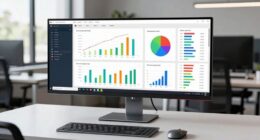You can earn some quick cash today with essential apps that can help you monetize your free time. Give Swagbucks a try for cashback on purchases and games, or make money by taking surveys with Survey Junkie or iPoll. If freelance work is more your style, TaskRabbit can connect you with local gigs, while Fluid Market allows you to rent out tools. For those with a creative touch, consider selling your photos on Foap or eco-friendly products on Musely. Need to make money fast? Bookscouter can help you sell your old books. These apps provide flexibility and opportunities for quick cash, making it easier than ever to increase your income. There’s a whole world of possibilities to explore!
Key Takeaways
- Swagbucks allows users to earn points through online shopping and gaming, which can be redeemed for cash or gift cards.
- Survey Junkie offers an easy way to earn cash by completing surveys, with a low cash-out threshold of $10.
- Rakuten provides cashback on online purchases, with potential returns up to 40%, and quarterly payouts via PayPal or checks.
- TaskRabbit connects users with local tasks, allowing flexibility to choose gigs that match your skills and schedule for extra income.
Market Research Apps

Market research apps offer you a straightforward way to earn cash by sharing your opinions through surveys, games, and various tasks.
Apps like Money and iPoll focus on rewarding you for completing surveys, while Swagbucks allows you to earn points for online shopping and gaming.
With Survey Junkie, you can quickly cash out at a low threshold of just $10.
If you enjoy creating surveys, Toluna lets you earn cash through PayPal, making it easy to get paid.
These apps not only provide a fun way to express your thoughts but also help companies gather valuable insights.
Cash and Cashback Opportunities

In addition to sharing your opinions through surveys, you can also maximize your earnings with cash and cashback opportunities that reward you for your everyday shopping habits.
Apps like Rakuten offer cashback on online purchases, giving you up to 40% back from participating retailers. You'll receive quarterly payouts via PayPal or checks, making it easy to access your earnings.
InboxDollars provides cash for surveys and shopping, with a minimum cash-out of $30.
If you're looking for a more passive reward, Slidejoy pays you for ads on your lock screen.
Gig and Task-Based Earnings

Gig and task-based earnings offer a flexible way for you to monetize your skills and spare time by connecting with local opportunities tailored to your interests.
Apps like TaskRabbit let you pick up tasks in your community, from assembling furniture to running errands, allowing you to earn based on your availability and expertise.
If you have tools or vehicles to spare, Fluid Market enables you to rent them out, potentially raking in significant income.
With these platforms, you can choose tasks that align with your schedule and skills, making it easy to create extra cash flow.
Immerse yourself in these gig opportunities, and you'll find that earning money has never been more accessible and convenient.
Creative Selling Platforms

Exploring creative selling platforms opens up new avenues for you to monetize your artistic talents and unique products, complementing the gig economy's flexible opportunities.
Apps like Foap let you sell your smartphone photos to brands, giving you $5 per sale while participating in missions for specific requests.
If you're passionate about eco-friendly goods, Musely allows you to earn a 20% commission on the products you sell.
These platforms not only provide a marketplace for your creations but also help you connect with like-minded individuals.
By leveraging these apps, you can turn your creativity into cash, making it easier than ever to earn on your terms.
Start showcasing your talents and watch your earnings grow!
Usability Testing Applications

Usability testing applications offer a straightforward way for you to earn money by providing valuable feedback on websites and apps.
These platforms, like Userfeel, pay you to navigate a site or app, sharing your thoughts on usability and design. You can typically earn around $10 per test, making it a great side gig.
The process usually requires you to complete a short qualification test before you can start. The more tests you take, the more money you can earn, so consistent engagement is key.
With varying time commitments, you can easily fit these tests into your schedule. Plus, your insights help improve user experiences for others, making your feedback even more valuable.
Book Selling Solutions

If you have old books lying around, selling them can be a simple way to make some extra cash. One of the best apps for this is Bookscouter.
Just scan the barcodes of your books, and it'll show you the highest buyer prices available. You can compare offers and choose the best one. Plus, they provide free shipping for sold books, making the process even smoother.
Once you've sold your books, you'll get paid quickly, which is great for immediate cash. Whether it's textbooks, novels, or reference books, you can declutter your space while earning some money.
Future Trends in Earning Apps

As the demand for flexible earning opportunities rises, earning apps are evolving to cater to users' changing needs and preferences.
You'll notice a surge in eco-friendly product markets, allowing you to earn while supporting sustainability.
AI advancements are streamlining market research, making it simpler for you to participate in surveys and usability testing.
Expect more apps to incorporate community features that enhance engagement and connection among users.
Influencer marketing will also grow, providing new avenues for earning through collaborations and promotions.
With continued user feedback shaping app functionalities, you can look forward to improved usability and satisfaction in your earning experiences.
These trends promise to make earning cash through apps even more accessible and rewarding for you.
Conclusion
In a world where time is currency, these must-have apps can transform your spare moments into real cash.
Whether you're diving into market research or selling your creativity, there's something for everyone.
As you explore these opportunities, remember that even the smallest efforts can snowball into significant earnings.
So, don't wait—download these apps today and start turning your free time into financial freedom.
Your wallet will thank you for it!









